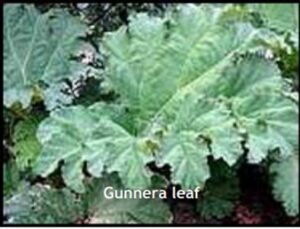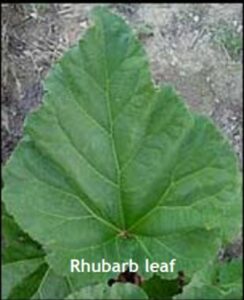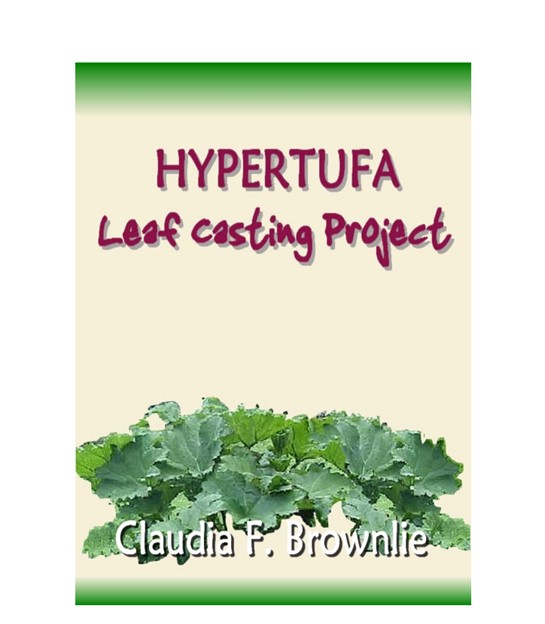Hypertufa-Leaf-Casting-Project
Hypertufa-Leaf-Casting-Project – Making leaf castings in hypertufa is quite a popular project. I get many questions about the ins-and-outs of how to make them.
This tutorial will guide you successfully through the steps and I am sure you’ll be on your way to adding one (or more) of these beautiful garden art objects.
And I must mention … remember to practice safety first! You’re dealing with Portland cement, which is caustic. Wear your gloves; wear your goggles; and wear your face mask.
For complete information on all you need to know about working with hypertufa safely, please refer to Chapter Five in “The Hypertufa How-To Manual“.
Also, leaf casting can be a bit tricky. Getting the hang of finishing the edges, for instance, may take a bit of trial and error to become successful.
You do want to taper off the ‘tufa as you get to the leaf’s edge, but not so thin that a part will crack off, either during the cure or on-up-the-road.
Remember: practice makes perfect. Start with smaller leaves, then progress to bigger ones.
I also recommend you use some sort of fortifier in your recipe. Refer to “The Hypertufa How-To Manual” for more recipe information.
Note: You can learn all about my 100+ page expert teaching resource and reference manual by clicking on this link: “The Hypertufa How-To Manual” How to Become a Mud-Pie Maker Extraordinaire
So that you are aware, but not to discourage you in any way from doing this project, you cannot make finely detailed castings of leaves with hypertufa.
The nature of the ‘tufa recipe ingredients does not make a super smooth mixture.
Hypertufa Leaf Casting Project
MATERIALS NEEDED


Leaf: it is preferable to use one with deep veining
Many leaves wilt quickly, so don’t harvest it until you have everything mixed up and ready to go; or keep your leaf in a bucket of water until you’re ready. Cut the stem off at the base of the leaf.
Some ideas for leaves to use for this project:
Small leaves: Oak, Maple, Hosta
Large leaves: Rhubarb, Giant Hosta, Canna, Ligularia,
Elephant ear Caladium, Gunnera
1 large bag of sand (any kind will do)
As an example, a rhubarb leaf will need a 40-lb. bag
Your favorite hypertufa recipe
For stronger leaves and/or larger leaves: use an admix recipe; you may also want to use drywall joint tape in addition to admix recipe; for a large size leaf (like a rhubarb) you will more than likely use almost an entire 40-pound bag of Portland cement — gauge your other ingredients accordingly.
Optional: chicken wire, drywall joint tape or hardware cloth for extra strength of the finished leaf
Water
Plastic wrap
Paint or stain (optional)
PROJECT INSTRUCTIONS
1. Important: to get the finest visible veining details possible for your leaf, our must FINELY pulverize the peat moss. Chucks of peat moss in your recipe are NOT recommended for this particular project.
5. Cover the entire mound and surrounding edge with the plastic wrap.
6. Lay the leaf face down on top of the plastic wrap. Make sure it extends a couple of inches past the leaf edges.
]7. Optional step: apply a release agent to the back side of the leaf (the side that is now facing you). Many people say Vaseline is the best. Do not use a cooking oil spray like Pam. It doesn’t work well.
Note: for more information on release agents, please refer to
Chapter Ten in “The Hypertufa How-To Manual”.
8. Mix your hypertufa recipe. For this project, get it to about the consistency of peanut butter, or very thick cake batter. You need to be able to pat it on and also push it around easily, especially to get it out the edges of the leaf.
9. Start patting on small handfuls of hypertufa. Work from the center of your leaf out to the edges. Keep the thickness of the ‘tufa consistent –apply at least a ¾” layer. Be careful not to push too hard — don’t tear a hole in the leaf.
10. Optional application method: put down a layer of the ‘tufa mixture and then add strips of drywall joint tape, hardware cloth, or chicken wire. Spread another layer of ‘tufa on top of the reinforcing material to completely cover it.
11. Make very sure to gently PUSH the ‘tufa into the leaf. You want to capture all the veins and crevices. This is what will make it realistic when it cures!
12. Smooth off the ‘tufa on the leaf’s edge. The more time you take to follow the shape of the leaf, the more realistic it’s going to look when completed. Make sure you’ve applied the ‘tufa thick enough around the entire edge so it won’t crack off.
READ MUCH MORE INSIDE…
Hypertufa-Leaf-Casting-Project

 Our 100% Money Back Guarantee:
Our 100% Money Back Guarantee:
If for any reason you decided within 30 days that ” Hypertufa-Leaf-Casting-Project“ isn’t for you, simply notify us by email and we’ll gladly refund your money – no questions asked. That’s our Ironclad Guarantee! The risk is entirely ours! You absolutely have nothing to lose!
Warmest Regards,
Coyalita Linville
Copyright © 2023 – 2024 Sunrise-Sunset-Nature-Gardens.com. All Rights Reserved Privacy Policy – Earning Disclaimer – Terms of Use – Contact Us

